FALL CONFERENCE ADVANCE REGISTRATION AND HOTEL DEADLINE APPROACHING



Save When You Register by September 28
Secure your savings—and your room—when you register for the 2023 AAN Fall Conference by September 28. Taking place October 27 through 29 both in person at the Paris Las Vegas Hotel and online, this year’s innovative program promises the latest updates on relevant neurologic topics, practice management and science sessions, and opportunities to earn up to 51.5 valuable end-of-year CME. Consider joining a day early to attend the special Advanced Practice Provider Pre-conference on Thursday, October 26. If joining us in person, you’ll also have opportunities to network with colleagues and external companies that have products and services to advance your practice and improve patient care.
Continued on page 5 ›
AAN Finds Victories in Proposed Medicare Physician Fee Schedule
Each year, the Centers for Medicare & Medicaid Services (CMS) proposes regulations that impact the reimbursement of physicians. On July 13, 2023, CMS issued a proposed rule updating payment policies and rates for physicians paid under the Medicare Physician Fee Schedule in 2024. The proposed rule illustrates the importance of the AAN’s regulatory advocacy efforts on behalf of neurologists and their patients.
CMS is projecting that the overall impact of changes contained in the proposed rule will result in a one-percent increase in payments to neurology as a specialty broadly. Due to the phase-out of temporary relief measures contained in the Consolidated Appropriations Act of 2023 and statutory budget neutrality requirements, CMS is currently predicting a reduction in the Fee Schedule conversion factor of approximately 3.4 percent. The AAN will continue to work with legislators to offset the impacts of statutorily required cuts. The AAN is committed to payment reform efforts to promote
Continued on page 10 ›
October 17 Is Deadline to Submit Abstracts for 2024 Annual Meeting

Present your transformative research and innovative advancements on neurology's biggest stage! Abstract submissions for the 2024 Annual Meeting will be accepted until 11:59 p.m. CT on October 17, 2023, in all subspecialties and career levels. The non-refundable submission fee is $125 for AAN members and $225 for nonmembers. Submission is free for residents and medical students. Visit AAN.com/AMAbstracts for more information and to submit. For questions, contact Katie Anderson at science@aan.com

2024 Annual Meeting Course
15 AAN Advocacy Expresses Needs of Neurology to Lawmakers and Regulators 7 View, Use Updated ALS Quality Measurement Set 13 Neurology Today Wins Top Award for Russian-Ukraine War Articles VOLUME 35 ISSUE 9 SEPTEMBER 2023
Due September 7
an idea for a course at the 2024 Annual Meeting? We want to hear it! Visit AAN.com/CourseProposal to submit your 2024 Annual Meeting course proposal(s) today. AAN.com/Fall • #AANFC Las Vegas and Online October 27–29
Proposals
Have

The Mission of the AAN is to promote the highest quality patient-centered neurologic care and enhance member career satisfaction.
The Vision of the AAN is to be indispensable to our members.
Contact Information
American Academy of Neurology
201 Chicago Avenue Minneapolis, MN 55415
Phone: (800) 879-1960 (toll free) (612) 928-6000 (international)
Email: memberservices@ aan.com
Website: AAN.com
For advertising rates, contact: Michael J. O’Brien II
Account/Relationship Manager
Wolters Kluwer
Phone: (978) 578-4514
Email: Michael.Obrien @ wolterskluwer.com
September Highlights 12
Meet Your New Board Member: Jeffrey C. McClean II, MD, FAAN

Jeffrey C. McClean II, MD, FAAN, is currently chair of the Department of Medicine at Brooke Army Medical Center (BAMC), the largest, busiest hospital in the Department of Defense health system. Previously, McClean was deputy chair for the BAMC Department of Medicine, and prior to this, he served four years as the program director of the only neurology residency in the US Air Force.
13
New Diversity, Equity, and Inclusion Associate Editor Named
Nicole Gonzales, MD, has been appointed as DEI associate editor of Neurology ® journal and began her work on August 1. She serves alongside DEI Associate Editors Roy H. Hamilton, MD, MS, FAAN, and H.E. Hinson, MD, MCR, FAAN.

14
Massey Recognized for Exceptional Mentorship
AAN Chief Executive Officer: Mary E. Post, MBA, CAE

Former AAN Board Member Janice M. Massey, MD, FAAN, was recently named the recipient of the 2023 Leading in Excellence Through Mentorship Award recipient.
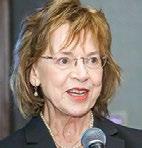
Editor-in-Chief: Melissa W. Ko, MD, MBA, CPE, FAAN

Managing Editor: Angela M. Babb, MS, CAE, APR
Editor: Tim Streeter
Writers: Ryan Knoke and Sarah Parsons
Designer: Siu Lee
Email: aannews@ aan.com
AANnews® is published monthly by the American Academy of Neurology for its 40,000 members worldwide. Access this magazine and other AAN publications online at AAN.com.
The American Academy of Neurology ’s registered trademarks and service marks are registered in the United States and various other countries around the world.
“American Brain Foundation” is a registered service mark of the American Brain Foundation and is registered in the United States.
The inclusion of advertisements and/or promotions of Sponsors and other Internet sites or resources that offer content, goods, or services on the Website does not imply endorsement of the advertised/promoted products or services by AAN.
News Briefs
Trainee Focus Groups Offer Input
The AAN hosted three focus groups with residents and fellows at the 2023 Annual Meeting to determine their support needs. Trainees are appreciative of many of their membership benefits including Continuum®, other educational resources (e.g., Question of the Day app), discounted Annual Meeting registration/ dues, scholarships, and awards. Residents are still concerned about the timing of fellowship applications and would like the AAN to continue advocating for a unified application timeline and process. Trainees suggested that the AAN consider creating more resources to assist with subspecialty exploration. For example, a podcast where physicians talk about their career paths, videos with subspecialty panelists discussing their work setting and daily schedules, and additional networking events at meetings to connect trainees with subspecialists.
AANnews · September 2023
Testimony on New Alzheimer’s Drugs Continues the AAN’s Legacy of Advocacy

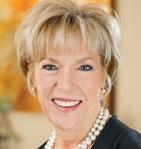
In this issue, we look back at 75 years of AAN advocacy for neurologists and their patients. From its inception, the Academy was almost immediately working its way through the corridors of power in Washington, DC, as President A.B. Baker, MD, FAAN, and President Elect Pearce Bailey, MD, FAAN, pushed for the creation in 1950 of what we know today as the National Institute of Neurological Disorders and Stroke.
Fast forward to the Rayburn House Office Building on July 18, 2023. The AAN was invited to testify before the House Energy and Commerce Committee hearing on “Innovation Saves Lives: Evaluating Medicare Coverage Pathways for Innovative Drugs, Medical Devices, and Technology.” Representing your Academy and more than six million Americans living with Alzheimer’s disease, their caretakers, and the neurologists who treat them was our President Elect Natalia S. Rost, MD, MPH, FAAN, FAHA. Dr. Rost addressed new monoclonal antibody therapies recently approved for the treatment of early Alzheimer’s disease, particularly how the recent Food and Drug Administration approval for lecanemab and the National Coverage Determination (NCD) by the Centers for Medicare & Medicaid Services impact Medicare patients’ access to this drug.
“The AAN has been engaged on issues surrounding monoclonal antibodies directed against amyloid for the treatment of Alzheimer’s disease for more than two years,” said Dr. Rost in her opening statement. “The goal of the AAN’s advocacy has always been to ensure appropriate access to these new therapies for patients in need. Shortly after the accelerated approval of aducanumab in the summer of 2021, the Academy participated in the National Coverage Analysis initiated by CMS to investigate appropriate coverage for aducanumab for the Medicare population. The AAN submitted comments and met with the Coverage Analysis Group at CMS to contribute to that analysis and was ultimately proud to have been cited extensively
throughout the resulting NCD. Many of the AAN’s recommendations relating to study protocol requirements, care-team design, and loosening of site-of-service limitations were ultimately incorporated into the final NCD. However, there was one key disagreement the AAN had with the proposed NCD.”
Dr. Rost went on to explain the AAN’s concerns that the NCD for this “first-in-class” agent is being applied to the entire class of monoclonal antibodies (mAbs) directed against amyloid for the treatment of AD, even as multiple therapies are in various stages of the approval process that work through the same mechanism but for which the full body of evidence is not currently publicly available. “The AAN is concerned that results from trials in progress for upcoming therapies may demonstrate evidence of meaningful clinical benefits that will not warrant the same restrictions as proposed in this NCD.”
She told the committee that the AAN had asked CMS for an "off-ramp" to be created within this NCD that would allow for a therapy demonstrating safety and effectiveness to be reconsidered in a nimble and effective way without the need to restart the NCA/NCD process.

“Unfortunately, the AAN’s concerns have ultimately come to pass,” Dr. Rost continued. “CMS’ decision to implement a class-wide determination and the lack of a nimble process to update the NCD as evidence emerges for impacted products and subpopulations has necessitated a need for further reconsideration of the existing coverage policy.”
Dr. Rost explained that, working with the subject matter experts and leadership, the AAN has identified a subset of patients for whom there is conclusive peer-reviewed evidence available demonstrating the safety and effectiveness of lecanemab and recommends those patients be removed from the Coverage
4 A ANnews • September 2023 PRESIDENT'S COLUMN
Jackson
President Elect Natalia S. Rost, MD, MPH, FAAN, FAHA, testified before the House Energy and Commerce Committee on July 18.
with Evidence Development (CED) requirements to ensure access outside of the existing study requirement. “Not only would this relieve these patients from any burdens associated with study participation, but it would also create the clear ‘offramp’ that is needed to ensure that CED is not indefinite, nor required of all Medicare beneficiaries, regardless of available evidence. As evidence is gathered on other patient populations, these criteria could be adjusted efficiently to broaden access.”
As she deftly fielded questions from the committee representatives on both sides of the aisle about such concerns as criteria for clinical trials for lecanemab and access to diagnostics, Dr. Rost mentioned the AAN by name numerous times and drove her message home on the need to increase the neurology workforce. Her comments prompted a couple of the lawmakers to mention they have family who grapple with brain diseases, illustrating how connecting with personal stories can help shape political outcomes.
Dr. Rost’s invited testimony continues efforts of the AAN to advocate for access to safe and effective treatments with Congress and federal agencies such as the CMS and the Food and Drug Administration. We have endeavored to keep members informed of these developments and their impact on their patients, such as the Academy’s 2022 Evidence in Focus document summarizes the level of evidence regarding aducanumab for patients with Alzheimer’s disease and reviews clinical considerations about its use, as well as a more recent document published July 26 in Neurology®―"Antiamyloid Monoclonal Antibody Therapy for Alzheimer Disease: Emerging Issues in Neurology"―which reviewed available information on lecanemab, aducanumab, and donanemab.
Even though there were several physicians and two pharmacists on the House Energy and Commerce Committee listening to Dr. Rost’s testimony, we know that only neurologists can accurately and effectively represent neurology and the unique nature of the many brain diseases we treat and the patients who live with them. Through years of effective representation by member leaders and staff, we have earned the respect of Congress as trusted authorities in this arena. Your participation in contacting your lawmakers when you receive Action Alert emails reinforces our expertise and our responsibilities to our patients—their constituents.
On September 22, we will hold our next Legislative Summit in Washington, following on the heels of our second annual Brain Health Summit. You will hear more about both events in the weeks following and how the AAN continues to champion our profession on behalf of our patients. Just as it has done for 75 years!
Fall Conference Advance Registration and Hotel Deadline Approaching

continued from cover
Add On Demand for an Even Better Value!
Gain extended access to session recordings, program materials, and ability to claim CME through August 1, 2024, by adding Fall Conference On Demand to your registration for a savings of up to 55-percent off the standalone On Demand price.

Visit AAN.com/Fall to learn more and secure your advance registration savings and book your hotel at the AAN’s discounted rate before September 28.
October
Carlayne E. Jackson, MD, FAAN President, AAN cjackson@aan.com @CarlayneJackson on Twitter



A ANnews • September 2023 5 EVENTS
AAN.com/Fall • #AANFC Las Vegas and Online
27–29
EVENTS
Summer Conference a Success with Attendees

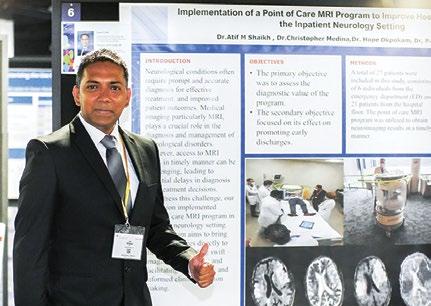

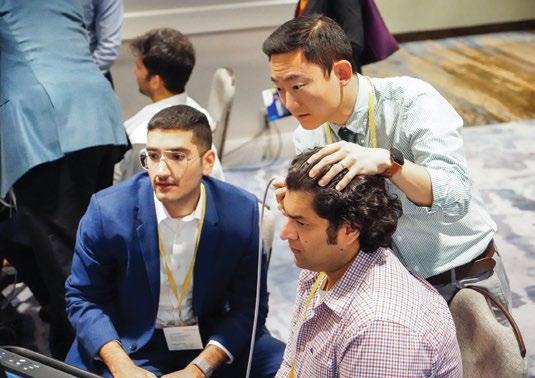
The AAN’s hometown of Minneapolis was the scene for the recent AAN Summer Conference: Emergency and Hospital Neurology, the first time this topic was presented to members over a two-day program. Attendees enjoyed a range of didactic and hands-on skill-building sessions featuring the latest in clinically relevant scientific advances and case-based updates in all important neurohospitalist and neurocritical care topics.

Minneapolis and Online
Are You Involved with Your Local Contractor Advisory Committee?
The Centers for Medicare & Medicaid Services (CMS) contracts with insurance carriers known as Medicare Administrative Contractors (MACs) to administer the Medicare program in assigned jurisdictions. In addition to processing and paying claims, the MAC’s scope of work includes establishing Local Coverage Determinations (LCDs) for certain services when there is no established national policy. While the Contractor Medical Director (CMD) makes all final determinations, they do receive input from a variety of sources including the Contractor Advisory Committee (CAC).
MACs must form CACs for each state within their jurisdiction. CAC representatives provide CMDs with specialty-specific input and comments on certain LCDs, which define the conditions that must be present for a specific procedure/service to be covered. At the beginning of the policy-making process, CMDs release draft LCDs with a 45-day minimum comment period. During that time, CMDs may receive input from CAC members, impacted physicians/specialty societies, and other interested stakeholders. All neurologists, APPs, and business administrator membership types can join their local CAC. If you are concerned about government payment matters, the AAN encourages you to join your state’s CAC. Being a CAC representative, you experience a much deeper understanding of how policy development works. If you are unable to serve on the CAC yourself, you should encourage members of your practice or state component society to join. The CAC only addresses Medicare, but the influence of Medicare decisions carries weight for many other payers.
José M. Rocha, MHL, director for FirstChoice Neurology in Medley, FL, explained why it is important to be a member of

a CAC. “On the team I am on, there is an ophthalmologist, retired podiatrist, and nephrologist. None are qualified to speak on EMG/NCV, SUDOSCAN, Botox injections, or VNG—all policies that were updated in 2023 for our MAC.
“CMS comes up with policies due to statistical reports. These statistical reports have no meaning unless a provider of this care can explain why an office visit might be necessary for a Botox patient. Or why this diagnosis is appropriate for this procedure. Or why the procedure might be repeated twice in a year or more. Being involved is crucial to make sure neurology patients’ needs are represented in payment policies that might affect the delivery of care.”
If you are a member of your local CAC, or if you are interested in learning more about the CAC selection process or about your local CAC, contact practice @ aan.com
View, Use Updated ALS Quality Measurement Set
The AAN published an update to the ALS quality measurement set in the August 1, 2023, issue of Neurology®. The new set includes six quality measures:

ALS support services
Disease-modifying pharmacotherapy discussion
Malnutrition and dysphagia screening
Multidisciplinary care plan
Respiratory impairment screening and appropriate intervention
Patient care preferences
This update to the original quality measurement set was developed by AAN Quality Measure Subcommittee with input from multidisciplinary team members.
Read the executive summary at Neurology.org and the full measure set and tools on AAN.com
A ANnews • September 2023 7 PRACTICE
Rocha
Where the Top Jobs and Top Talent Connect!
From first job to career shift, get access to the latest openings, candidate CVs, and timely resources to seal the deal.

ADVOCACY
Capitol Hill Report
Capitol Hill Report presents regular updates on legislative and regulatory actions and how the Academy ensures that the voice of neurology is heard on Capitol Hill. It is emailed to US members twice monthly and is posted at AAN.com/view/HillReport. Below are some recent highlights.
Latest Advocacy News
On July 26, the AAN submitted comments in response to a new proposed coverage pathway from the Centers for Medicare & Medicaid Services (CMS) for innovative medical devices, known as the Transitional Coverage for Emerging Technologies (TCET) pathway. This proposal primarily focuses on Medicare coverage policies for medical devices with the goal of identifying new approaches “to make decisions on certain new items and services, such as medical devices, more quickly to provide expedited access to new and innovative medical technologies.” TCET is voluntary and aims to reduce uncertainty about coverage options through the use of coverage with evidence development processes to expedite Medicare coverage of certain breakthrough devices.
Citing the steps the agency has taken to reduce data submission burden, on July 28, CMS rejected the AAN’s reconsideration request for coverage for monoclonal antibodies for the treatment of Alzheimer’s disease. The AAN is committed to holding CMS accountable for updating the coverage policy based on emerging evidence.
The AAN led a coalition of 50 organizations in sending a letter in support of the Conrad State 30 and Physician Access Reauthorization Act (S.665/H.R.4942). The AAN has been a longtime supporter of this legislation supporting the Conrad 30 program and international medical graduates and continues to lead efforts on Capitol Hill to advance this legislation. This bill, introduced by Sens. Amy Klobuchar (D-MN) and Susan Collins (R-ME) and Reps. Brad Schneider (D-IL), Don Bacon (R-NE), David Valadao (R-CA), and Sylvia Garcia (D-TX), would reauthorize and expand the Conrad 30 program and make several targeted policy improvements.
Issue in Focus
Thirty AAN members gathered in San Diego for the 20th annual Palatucci Advocacy Leadership
Forum (PALF), moderated by Justin Jordan, MD, MPH, FAAN. The award-winning event focuses on teaching members the skills necessary to become advocacy leaders in their clinics, institution, or communities.


Attendees began the weekend by identifying a specific issue and worked throughout the weekend with their advisor and several faculty members to solidify their goal and create a workable action plan.
On Friday, attendees focused on media and communications, sitting for mock interviews and developing the skills necessary to tell their story. Saturday’s programming focused on grassroots and legislative training, where attendees got an inside look at how government works and how to get results. By the end of the weekend, attendees left with next steps in place to complete their action plans and joined a PALF alumni network of over 550 graduates.
A ANnews • September 2023 9
Palatucci Advocacy Leadership Forum Faculty members (from left) Kara Stavros, MD, FAAN; Jonathan Santoro, MD; and Tyler Allison, MD, FAAN, during the Faculty Showcase program for attendees.
Moderator Justin Jordan, MD, MPH, FAAN, participates in the mock testimony as part of the legislative training.
AAN Finds Victories in Proposed Medicare Physician Fee Schedule
continued from cover
a sustainable payment system, such as ensuring physicians receive an inflationary adjustment tied to the Medical Economic Index, and to working with regulators and legislators to ensure that CMS appropriately values the work done by neurologists.
Evaluation and Management (E/M) Visits
In a significant win for AAN advocacy, CMS is proposing to delay policies impacting split (or shared) E/M visits that were set to go into effect on January 1, 2024, until January 1, 2025, to allow for further dialogue with stakeholders. The proposed rule specifically calls out concerns raised by the AAN and other aligned stakeholders that these changes pose a threat to current practice patterns of team-based care. CMS acknowledges the work that is being done currently through the CPT Editorial Panel to clarify the importance of medical decision making in identifying the billing provider.
Citing stakeholder concerns regarding the process by which values for E/M services are updated, CMS is requesting comments on how best to evaluate E/M services more regularly and comprehensively. This is in line with long-term AAN advocacy that has raised the need for consistent updates for E/M services to offset the impacts of passive devaluation of these services stemming from the Fee Schedule’s budget neutrality requirements.
CMS is proposing to cover office/outpatient E/M visit complexity add on code G2211 effective January 1, 2024. The code is intended to capture the visit complexity for those patients whose overall, ongoing care is being managed and monitored by a specialist for a particular condition. The AAN is pleased with the agency’s proposed coverage, however, will carefully review all the provisions including the proposal that G2211 would not be payable when the E/M visit is reported with modifier 25.
Telehealth Regulations
CMS is implementing key provisions of the Consolidated Appropriations Act (CAA) of 2023 that extend certain flexibilities in place during the COVID-19 Public Health Emergency (PHE) through December 31, 2024. These key changes include allowing telehealth services to be furnished in any geographic area and in any originating site setting, including the beneficiary’s home, allowing certain services to be furnished via audio-only telecommunications systems, and continued coverage of services temporarily added to the Medicare Telehealth list through December 31, 2024. CMS is also proposing beginning in 2024 that telehealth services furnished to beneficiaries in their homes be paid at the non-facility rate to protect access to mental health and other telehealth services.
When adding certain services to the Medicare Telehealth List, CMS had previously included restrictions on how frequently a service may be furnished via telehealth. CMS is proposing to
remove the telehealth frequency limitations for the following codes through 2024:
Subsequent Inpatient Visits: CPT Codes 99231–99233
Subsequent Nursing Facility Visits: CPT Codes 99307–99310
Critical Care Consultation Services: HCPCS Codes G0508 and G0509
Citing concerns that modifying current policy relating to direct supervision may present a barrier to access, CMS is proposing―consistent with the AAN’s advocacy―to continue to define direct supervision to permit the presence and “immediate availability” of the supervising practitioner through real-time audio and visual interactive telecommunications through December 31, 2024. CMS will continue to evaluate the appropriateness of making this policy permanent.
In alignment with the telehealth policies that were extended under the provisions of the CAA, CMS is also proposing to allow teaching physicians to have a virtual presence in all teaching settings, only in clinical instances when a service is furnished virtually. This would permit teaching physicians to have a virtual presence during the key portion of the Medicare telehealth service for which payment is sought, through audio/video real-time communications technology, for all residency training locations through December 31, 2024. The virtual presence policy would continue to require real-time observation by the teaching physician and excludes audio-only technology.
CMS declined to permanently add several codes that are temporarily included on the Medicare Telehealth List, citing a need for further evidence generation. These include:
Deep Brain Stimulation: CPT Codes 95970, 95983, and 95984
Inpatient Hospital or Observation Care: CPT Codes 99221–99223, 99234–99236
Inpatient Hospital Observation Discharge Day Management: CPT Codes 99238 and 989239
Emergency Department Evaluation and Management: CPT Codes 99281–99283
Appropriate Use Criteria
Since 2014, CMS has been working to implement a program that requires practitioners to consult a qualified clinical decision support mechanism at the time the practitioner orders an advanced diagnostic imaging service for a Medicare beneficiary. The AAN has repeatedly expressed concerns about the feasibility of this program, the subsequent increase in administrative burden, and the unintended consequences it would have on practice patterns. CMS has continually delayed implementation of the penalty phase of this program and, in a significant win for AAN advocacy, CMS has now proposed to suspend the program indefinitely to allow for reevaluation.
10 A ANnews • September 2023 ADVOCACY
Medicare Economic Index
CMS had previously finalized a policy to update the Medicare Economic Index (MEI) to reflect more current market conditions faced by physicians in furnishing physicians' services. Although the agency finalized this policy, CMS chose to delay implementation, citing a need for further comment. Based on stakeholder feedback, CMS is proposing to not incorporate the updated MEI methodology for PFS rate-setting in 2024. CMS will continue to solicit feedback on how to update this index, including data collected through a forthcoming American Medical Association-led effort.
Changes to Payment for Drugs and Biologics Under Part B
The proposed rule makes a variety of updates to regulatory text to reflect provisions of the Inflation Reduction Act. Language is being added to codify the Medicare payment methodology for drugs and biologics that do not yet have adequate data to determine an Average Sales Price (ASP). These interim payment amounts are determined based on the Wholesale Acquisition Cost instead. In the case of biosimilars, the reference biologic’s ASP is used as well. This section also codifies a $35 out-of-pocket cap for insulin.
CMS also seeks comment on coding and payment policies for complex non-chemotherapeutic drugs, in an effort to promote coding and payment consistency and patient access to infusion services.
Quality Payment Program MIPS
CMS proposes that for the 2024 performance period, the weights for MIPS performance categories remain the same as 2023: 30 percent for Quality, 30 percent for Cost, 15 percent for Improvement Activities, and 25 percent for Promoting
DATES & DEADLINES
SEPTEMBER
September 7
Submission Deadline: 2024 Annual Meeting Course Proposals AAN.com/CourseProposal
September 14
Application Deadline: 2024 Research Program Grants AAN.com/ResearchProgram
September 21
AAN Brain Health Summit
September 28
Interoperability. CMS also proposes to modify its methodology for determining the MIPS payment adjustment performance threshold to include three previous performance periods. Based on this methodology, CMS is proposing a performance threshold of 82 points for the Calendar Year 2024 performance period.
Neurology will not see major modifications to the Quality, Cost, and Improvement Activity categories. CMS has proposed policy modifications to the Promoting Interoperability category aimed at alleviating administrative burden. The proposed revisions would:
1. Lengthen the performance period for this category from 90 days to 180 days
2. Modify one of the exclusions for the Query of Prescription Drug Monitoring Program (PDMP) measure
3. Provide a technical update to the e-Prescribing measure’s description to ensure it clearly reflects our previously finalized policy
4. Modify the Safety Assurance Factors for Electronic Health Record Resilience (SAFER) Guide measure to require MIPS eligible clinicians to affirmatively attest to completion of the self-assessment of their implementation of safety practices
5. Continue to reweight this performance category at zero percent for clinical social workers for the CY 2024 performance period/2026 MIPS payment year
MIPS Value Pathways
Five new MIPS Value Pathways (MVPs) are being proposed in the rule including:
Women’s Health
Infectious Disease, Including Hepatitis C and HIV
Mental Health and Substance Use Disorder
Quality Care for Ear, Nose, and Throat (ENT)
Rehabilitative Support for Musculoskeletal Care
Visit AAN.com/qpp for more MIPS details.
Advance Registration and Hotel Deadline: AAN Fall Conference AAN.com/Fall
October
October 17
Submission Deadline: 2024 Annual Meeting Abstracts AAN.com/AMAbstracts
October 23–29
Neurology Career Week Careers.AAN.com
October 26 APP Pre-conference
Las Vegas and Online AAN.com/Fall
October 27–29
AAN Fall Conference
Las Vegas and Online AAN.com/Fall
October 31
Application Deadline:
Transforming Leaders Program and Women Leading in Neurology AAN.com/Lead
Meet Your New Board Member: Jeffrey C. McClean II, MD, FAAN

Jeffrey C. McClean II, MD, FAAN, is currently chair of the Department of Medicine at Brooke Army Medical Center (BAMC), the largest, busiest hospital in the Department of Defense health system. Previously, McClean was deputy chair for the BAMC Department of Medicine, and prior to this, he served four years as the program director of the only neurology residency in the US Air Force (USAF). He is an associate professor of neurology with the Uniformed Services University of the Health Sciences. He is also the neurology chief consultant to the USAF surgeon general, providing guidance for a network of neurology clinics across the country and overseas.
How did you initially get involved as a volunteer member for the AAN?
I was very fortunate to be selected for the Emerging Leaders Forum in 2013. When I applied, my primary goal was to develop my leadership skills, so that I could be more effective in roles at my home institution. To be honest, I wasn’t seeking opportunities for involvement with the Academy, because I knew very little about the AAN at the time. As I was exposed to the AAN, I was blown away by the commitment of the volunteers and staff to be indispensable to our members, and how much the AAN does to support us and our ability to care for our patients. Upon completion of Emerging Leaders, I knew I wanted to contribute to the organization, and I’ve since had the opportunity to be involved in Member Engagement; Leadership Development; Diversity, Equity, and Inclusion; as well as the Editorial Boards of Neurology ® and Brain & Life®
Why did you wish to be on the Board of Directors?
Through my participation with the AAN Leadership Programs, and my roles at my home institution, I have found it extremely energizing and rewarding to serve as a leader within organizations with missions, visions, and values that align with my own. As a result, I’ve continued to seek successive opportunities to lead and grow as a leader, particularly in the
AAN. Serving as a member of the Board of the AAN is a privilege, because I have the chance to be part of leading an organization with a huge impact on our field and how it will look not just today, but well into the future. We can’t predict all the challenges neurology will face in the coming years, but we know there will be many, and that the Academy will remain indispensable in addressing them. I am truly excited and honored to contribute in such a meaningful way.
What experiences and viewpoints do you bring to this role?
My work with Member Engagement, Leadership Development, the publications, and the DEI efforts have certainly shaped my perspective, as have my practice as a neuromuscular physician and experiences as a program director and department chair. Just as important, if not more so, it is very easy for me to recall being a member who didn’t know the AAN’s mission and vision or understand what the AAN does for its members, our field, or our patients. I believe it’s incredibly important that we always consider and communicate with the breadth of our membership, especially those that may be less familiar or engaged with the organization. Those are the members whose viewpoints are most likely to be overlooked if we are not intentional in ensuring they are represented.
Watch Email for Member Needs Assessment Invitation
The triennial Member Needs Assessment is open to receive your feedback! Watch your email for an invitation to complete the survey, which is used to help evaluate member needs. The AAN values your feedback to drive improvements to AAN member benefits, resources, and services to fulfill our mission and help you to provide the highest quality patient-centered neurologic care.
It is important that the AAN better understand why you belong and what matters most to you. Past surveys have helped the AAN to drive improvements to the Annual Meeting, AAN.com, online education, and more. The survey responses show AAN leadership where there are opportunities to improve and better understand the challenges you face, giving insights into how the AAN can continue to support you in the constantly evolving neurology landscape and stay relevant to you and your needs.
12 A ANnews • September 2023 MEMBERSHIP
McClean
New Diversity, Equity, and Inclusion Associate Editor Named
Inclusion is the reason the AAN was founded. The AAN is firmly committed to embracing the diversity of our members, staff, and the communities they serve, and affirms the need for equity and inclusiveness in our organization, our profession, and the care we provide for our patients. In this column, we share the wide spectrum of diversity, equity, and inclusion (DEI) work being done across the AAN.
Nicole Gonzales, MD, has been appointed as DEI associate editor of Neurology® journals and began her work on August 1. She serves alongside DEI Associate Editors Roy H. Hamilton, MD, MS, FAAN, and H.E. Hinson, MD, MCR, FAAN.
Editor-in-Chief José G. Merino, MD, MPhil, FAHA, FAAN, said, “Dr. Gonzales is an experienced clinician, researcher, and teacher with a sophisticated understanding of diversity, equity, and inclusion principles. Because of her broad background, she is able to evaluate manuscripts from a DEI
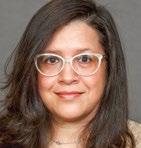
perspective, and help authors improve their papers, ensuring that research questions and projects dealing with diverse populations are adequately formulated and reported.”
Gonzales is professor and co-director for diversity, equity, and inclusion in the Department of Neurology at the University of Colorado Anschutz Medical Campus. She obtained her medical degree from McGovern Medical School at UTHealth, completed her neurology residency at the University of Colorado and completed a neurovascular
Connect with Other Members in Your Subspecialty or Area of Interest—It’s
Free!
Did you know that by joining an AAN Section or member community you can lend your voice to timely discussions and share ideas and concerns with other AAN members from around the globe who share your interests? Joining is a free benefit of your AAN membership and includes free access to associated SynapseSM Member Communities and the Synapse mobile app, where a growing number of participants are discussing the latest health care topics. Don’t miss out on the timely conversations going on right now—visit AAN.com/membership/sections to learn more and to download the app today!
AAN in the News
fellowship at McGovern Medical School. Gonzales has participated in many landmark clinical trials in acute stroke treatment and secondary stroke prevention. She is actively involved in fellow, resident, and student training. Gonzales is also committed to providing opportunities for exposure to medicine for historically excluded communities and developing mentorship programs for neurologists.
Neurology Today Wins Top Award for Russian-Ukraine War Articles
The AAN’s publication Neurology Today ® won the Grand Award—the highest award offered by the APEX Editorial competition—for its series of four articles on the response of neurologists (both in and outside Ukraine) to the Russian-Ukraine war. They won in the Magazine series category for Magazines, Journals, and Tabloids.
The first three articles were written by Immediate Past President Orly Avitzur, MD, MBA, FAAN, and the fourth by Gina Shaw.
“Dispatches from Ukrainian Neurologists: A Plea for Medicines and Peace” (https://bit.ly/3KhYqob)
“Epileptologists Unite Across the Globe to Aid Ukraine” (https://bit.ly/3EApmxq)
“Neurologists Volunteer Telemedicine Services to Ukrainians in Need” (https://bit.ly/38FYosC)
“‘These Are People Who Have Worth’: Reports from Ukraine on the Crisis for People with Developmental Disabilities” (https://bit.ly/3XMopf3)
A Neurology ® study featured in press release that found both cluster headache and migraine have strong links to the circadian system, the internal clock that regulates body processes, was mentioned by MSN, U.S. News & World Report, New York Post, and more. Another Neurology study featured in press release that found people with epilepsy have an increased risk of early death and the increased risk varies depending on where they live, the number of medications they take and what other diseases they may have, was covered by MSN, Medscape, Healthline, and more.
Gonzales
Massey Recognized for Exceptional Mentorship
Janice M. Massey, MD, FAAN, was recently named the recipient of the 2023 Leading in Excellence Through Mentorship Award. The award recognizes an exceptional mentor who has participated in one or more of the AAN’s Leadership Development Programs, made a significant impact in the life and career of their mentee(s), and encouraged their mentee(s) to maximize their potential and successfully achieve the goals set forth in their respective program.
In her nomination of Massey, 2019 Transforming Leaders Program graduate Amy Chen, MD, PhD, FAAN, said, “Dr. Massey is a forefront leader in neuromuscular medicine. She is generous in sharing her experience and knowledge, and genuinely interested in fostering mentees’ growth and development. Her insights and advice were influential in helping me develop a telehealth program in 2019 (pre-Covid!) to provide synchronized expertise
care for patients with neuromuscular diseases, who were located at an institution-affiliated spoke clinic. She is a role model for me and many, as she is a leader who inspires and motivates mentees to strive for excellence in a collective way. I am fortunate and grateful for Dr. Massey’s mentorship in the 2018–2019 Transforming Leadership Program and beyond.”

“I am most honored and pleased to receive this award,” said Massey, a former member of the AAN’s Board of Directors who has served as a mentor for the AAN’s Leadership Development Programs for six years.
“Serving as a mentor has been one of my most rewarding professional experiences. Mentoring initially seemed an ambiguous work when first asked to ‘mentor’ someone or a group. I presumed I would be faced with helping with specific problems. But, I learned it is not telling someone what to do but most typically involves simply listening and providing affirmation or perspective to the mentee. Many times, mentees know what direction to choose but are relieved if given encouragement.
Occasionally offering an alternative vision is helpful. Mentors serve as a ‘safe port in the storm,’ which everyone needs at some point in life.”
Applications Open for Women Leading in Neurology and Transforming Leaders Programs

Don’t miss your once-in-a-lifetime opportunity to participate in Women Leading in Neurology and Transforming Leaders programs. The application period will open September 19 and close October 31, 2023. Past participants of the AAN Leadership Development Programs have found them to be an essential supplement to their careers, the neurology profession, and patient care. Learn more about the programs and eligibility requirements at AAN.com/Lead

Educating the public on neurology and brain health. Episodes available weekly wherever you get your podcasts! BrainandLife.org/Podcast 14 A ANnews • September 2023 MEMBERSHIP
Massey
AAN Advocacy Expresses Needs of Neurology to Lawmakers and Regulators
During its early years, the AAN ’s advocacy efforts rested on the shoulders of founder A.B. Baker, MD, FAAN, and the Academy’s second president, Pearce Bailey, MD, FAAN. Bailey, whose father had been a distinguished New York neurologist, knew the circles of influence in both the Big Apple and on Capitol Hill, as he was the chief of the Neurology Section of the Veterans Administration Central Office and on staff at Georgetown University and the District of Columbia General Hospital.
Baker said of Pearce Bailey: “He probably is one of the smartest politicians who ever came to Washington. He knew everybody. He knew exactly when to move in which direction. He knew which people ought to be contacted to get things done. And his advice and help was tremendous in making the Academy move forward and getting accomplished that which would have taken us a long time without an open door to the right person or the right people who could help us get what we wanted. It was very good to have a man like Dr. Bailey on your side.”
“Abe could see the political future of neurology depended upon the establishment of an Institute,” related Francis M. Forster, MD, FAAN, in 1988. Bailey and Baker collaborated with Mary Lasker, a prominent New York socialite and medical research activist, a pair of Washington lobbyists, and several key congressional supporters to press for a single institute within the National Institutes of Health dedicated to neurology research. The NIH established the National Institute of Neurological Disorders and Blindness in November 1950.
“About the time of the [1951] Virginia Beach meeting, the director of the NIH, who was a biochemist and nutritionist, was invited to attend the meeting,” said Forster. “He was cultivated by Abe and the rest of us and the main thrust was to have Pearce Bailey, then in the VA Central Office, become the first director of the NINDB. This was accomplished.” Bailey was named director of the NINDB shortly thereafter and served in that capacity until 1959. The agency became known as the National Institute of Neurological Disorders and Stroke in 1968.

While the AAN enjoyed a close relationship with the NINDS in its early years, the institute’s increasing
budget drew greater congressional scrutiny, and its mandate and the collaborative associations with the Academy and other neurology organizations became more codified and bureaucratic. The Academy helped the NINDS secure congressional support for the Decade of the Brain in the 1990s. Though the NINDS budget stands at $2.8 billion for the 2023 fiscal year (out of an NIH budget of $47.76 billion), the Academy continues to monitor appropriations closely and advocates for increases that will help spur progress in neurologic research.
Member Needs Require Legislative Focus
While Baker continued to be a significant influence in Washington, the growth of practicing neurologists and the introduction of Medicare and Medicaid in the 1960s helped lead the Academy to establish the Practice Committee, with legislative affairs as part of its portfolio.

“A.B. was our most outstanding political figure in the very early days,” recalled Herbert Rosenbaum, MD, FAAN, first chair of the Practice Committee, in 2008. “However, Jack Segerson, Ed Davis, and I also donated much of our time to advocacy affairs on behalf of the Academy. When you’re only one percent of the physician population, getting your share of the pie takes a great deal of effort and sweat. However, we did make out fairly well. I clearly recall personally testifying before a House subcommittee in the middle 1960s in an effort to promote clinical neurologists to be considered primary care physicians

Continued on page 16 ›

A ANnews • September 2023 15
Pearce Bailey, MD, FAAN
John N. Whitaker, MD; Sen. Mark Hatfield (R-OR); Francis I. Kittredge, Jr., MD, FAAN; and Arthur Safran, MD, FAAN, 1992.
President Jack P. Whisnant, MD, FAAN, left, presented an award to Sen. Tom Harkin (D-IA), 1992.
President Kenneth M. Viste, Jr., MD, FAAN, testified before Congress.
MEMBERSHIP
AAN Advocacy Expresses Needs of Neurology to Lawmakers and Regulators

continued from page 15
from the standpoint of reimbursement. That was, of course due to the fact that neurologists acted as primary care doctors to many of our chronically ill neurology patients who looked to us for practically all of their systems care. Interestingly enough, this topic is probably just as relevant today as it was when it was first presented.”
To help address the increasing needs of members, the Legislative Affairs Committee (LAC) was started in 1986, followed by the State Affairs Committee in 2002. In the 1980s, the Academy was represented by Medical Advocacy Services, a for-profit subsidiary of the American Society of Internal Medicine, which focused largely on Medicare fee schedule issues.
In 1992, the AAN engaged the Washington, DC, firm of Powers, Pyles, Sutter & Verville (PPSV) to furnish legislative and regulatory services on federal matters affecting the AAN. PPSV helped the Academy with legislation including health care reform, Medicare payments, and NIH funding, as well as regulations such as those affecting physician payment, physician referrals, coverage of neurology-specific drugs by Medicare, and physician supervision of diagnostic tests. They also helped arrange meetings with Congress and members of the executive branch, testimony before Congress, and participation by AAN members on federal committees such as the Physician Payment Review Committee. When the Academy opened its Washington office in 2005, PPSV stepped back to a supporting role in legislative, regulatory, and coalition activities.
In 2007, the Academy launched neurology’s political action committee, BrainPAC, which raises donations from US members to support candidates for federal office who support the neurology profession and patients. “I think the BrainPAC is a good thing,” said Thomas R. Swift, MD, FAAN, who was president at the time, “simply because everything is a PAC now. If you want to gain access, and you want to support candidates that look at your position, it’s inevitable you have to—that’s how our system works.” His successor, Stephen M. Sergay, MB BCh, FAAN, agreed. “There were pros and cons, and then the vote was taken, I think at one of the very first meetings of Tom Swift’s presidency, if I remember correctly. All of us had some ambivalence because of the fact that we needed to support people whose policies we might not have believed in beyond what they were doing for medicine. We realized that was the game, and it needed to be done.” To date, BrainPAC has raised over $4 million to provide bipartisan support to elect or
reelect members of Congress who are sympathetic to the needs of the neurology profession and patients and caregivers dealing with brain disease.
Championing the Care of American Veterans

At least 10 AAN presidents saw active duty during World War II. Other leaders served in Korea, Vietnam, or elsewhere during the Cold War. Since the time of the Academy’s founding, their personal service has reinforced the AAN ’s commitment to quality veteran care.
John Booss, MD, FAAN, who was a major at the US Air Force School of Aerospace Medicine in San Antonio from 1971 to 1973, was appointed as the National Program Director for Neurology in the VA in 1993. This was due to the LAC’s successful lobbying to hire a neurologist to replace the acting director, whose primary responsibility was mental health.
“Clearly, the VA had not been paying as much attention to disorders of the nervous system as would have been needed,” said Booss. “There were about 90 hospitals in the system with at least some neurologic staff, with over 400 neurology staff nationally, considering both part-time and full-time neurologists. Further, the VA supported 23 percent of neurology residency positions nationwide, almost a quarter of the national total. One of my major tasks was to try to elevate the status of VA neurology nationally, and the AAN was crucial. Dr. Steve Ringel, then the chair of the LAC, was kind enough to appoint me as an ex officio member of the LAC. As a government employee, I was precluded from lobbying efforts, but I was permitted to inform interested groups as requested. Over the years, the LAC served as a sounding board for many VA neurology issues.”
Booss was able to participate in LAC advocacy efforts on the Hill after he retired from the VA in 2005. “Two gratifying efforts combined into one bill were the passing into law of permanent authorization for the VA’s MS Centers of Excellence and the VA’s Parkinson’s Disease Research, Education, and Clinical Centers, two systems of care that were developed in the VA during my tenure. That effort was a principal goal of the LAC and a coalition of the AAN, the Parkinson’s Action Network, the National Multiple Sclerosis Society, and the Paralyzed Veterans of America.” For his work on behalf of the Academy and neurology patients, Booss was named a co-recipient of the AAN ’s 2007 Advocate of the Year Award.
16 A ANnews • September 2023
John Booss, MD, FAAN, with Sen. Barack Obama (D-IL) after testifying on Epilepsy Centers of Excellence legislation, 2007.
AAN President Bruce Sigsbee, MD, FAAN, with Susan Collins (R-ME) at a BrainPAC fundraiser, 2009.
The Academy led a major effort to help veterans with epilepsy, including those with epilepsy following traumatic brain injuries received in Iraq or Afghanistan. With a push from the AAN, the Epilepsy Foundation, and several veterans’ service organizations, the VA Epilepsy Centers of Excellence were established by Congress in 2008, followed by Headache Centers of Excellence in 2018. We work with the Alliance for Headache Disorders Advocacy on the Headache Centers and lead a coalition with the four centers' patient groups to increase congressionally appropriated funding each year.
physicians are not highly regarded by health policy wonks or legislators. I learned how Congress works and legislation is passed. I even wrote a bill called the Clinical Research Enhancement Act that was eventually passed into legislation.”
Yerby’s dedication to advocacy led to him chairing the LAC from 2001 to 2007. “I think the fact that the AAN realizes that federal and state health policy is important enough to pay attention to and the fact that the membership is now more engaged is a great success. The use of the Vocus online advocacy system that easily enables US members to contact Congress on key issues was very important. The establishment of a Legislative Affairs Committee was also important. The BrainPAC will allow even a small organization like ours to be better heard on Capitol Hill.”

Grassroots Advocacy Training Builds Army of Advocates

Fellowships Expand Members’ Knowledge, Abilities
The old bromide “learn one, do one, teach one,” could be applied to the Academy’s strategy to expand its base of advocates. Based on two successful congressional fellowships held by Drs. Ira Shoulson and Steven P. Ringel in the early 1990s, the AAN joined with the American Neurological Association and the Child Neurology Society to create a Neurology Public Policy Fellowship in Washington. Its first recipient, in 1995, was Mark S. Yerby, MD, MPH, FAAN, who had done a residency in public health and developed a long-standing interest in health policy following his wife’s death from cancer.
“Her insurance company refused to pay for her cancer treatment because it was deemed ‘experimental.’ We were able to pay for her care out of pocket, but it cost us $50,000 the first year alone. After she died, I felt I needed to put some of my energy into health care reform. I saw a notice about the Academy’s Public Policy Fellowship and thought that might be a good approach.”

Fellows spent up to a year working with legislators and staff; Yerby’s assignment was the office of Sen. Mark Hatfield (R-OR).

“I learned a great deal from my public policy fellowship. The situation is very complex. Funding of health care is patchwork and irregular. There are many forces involved, most of whom are more concerned with cost than quality or even any distribution of care. I learned that
Recognizing there is indeed strength in numbers, the Academy has often joined with other neurology and patient organizations in Capitol Hill activities. But it has also recognized the need to develop its own army of grassroots advocates. Neurology on the Hill was created in 2003 to bring interested members to Washington, DC, for two days to learn more about national health care policies and how they affect their profession. Participants then meet with their state delegations to press them for favorable consideration of the Academy’s legislative agenda. The event has been very popular with members: in 2017, 216 AAN member advocates made 272 congressional office visits and sent 2,072 tweets generating 1.8 million social media impressions. “Academy green” bow ties and scarves give members a distinctive look as they work their way through the offices of the Senate and House.
Members can gain formal advocacy training through the Donald M. Palatucci Advocacy Leadership Forum (PALF). Developed as an intensive three-day training program to enable US and international neurologists to work more strategically and effectively on local or regional issues, graduates have joined
A ANnews • September 2023 17
Speaker of the House Nancy Pelosi (D-CA) with Marc R. Nuwer, MD, PhD, FAAN, 2010.
Jeffrey C. Kutcher, MD, FAAN, center, testified on sports concussion, 2011.
on page 18 ›
Mark S. Yerby, MD, MPH, FAAN, and Linda Y. Buchwald, MD, FAAN, presented an award to Sen. Ted Kennedy (D-MA).
Continued
Sen. Hillary R. Clinton (D-NY); Katherine A. Henry, MD, MEd; and Bert B. Vargas, MD, FAAN, 2007 Neurology on the Hill.
AAN Advocacy Expresses Needs of Neurology to Lawmakers and Regulators


continued from page 17
the Neurology on the Hill event to help establish contacts with their representatives in Washington and help promote the Academy’s national legislative agenda.

Lily Jung Henson, MD, MMM, FAAN, now serving as member of the Board of Directors, graduated from the first Donald M. Palatucci Advocacy Leadership Forum in 2003, and she continued to participate as a mentor and advisor. “The Palatucci Forum has been incredibly successful in creating advocates for neurology both here and abroad,” she said at the time. “The synergism amongst its graduates has helped the Academy’s advocacy efforts exponentially. As more members graduate from the forum, they build upon the foundation of those who came before them, and the results are obvious. For example, Drs. Maureen Callaghan, Anna Hohler, and I worked to develop the Washington State Neurological Society. Subsequent graduates of the forum have helped to sustain the work of the society. And as more of our colleagues learn about the program and the value it brings in helping them take better care of their patients, more are looking to become part of the Academy’s advocacy community.”
The forum—named in honor of the late Donald M. Palatucci, MD, FAAN, a member of the AAN Board and strong proponent of grassroots advocacy—has trained more than 593 Academy members, including 54 international members who confront challenges in their own countries. Their impact has been considerable, and several of these international members have been cited as AAN Advocates of the Year. “It is critically important that international neurologists develop vital advocacy skills that they can use to promote high-priority issues facing the practice of neurology in their home countries,”
said Mohammad Wasay, MBBS, of Karachi, Pakistan, co-recipient of the 2004 Advocate of the Year Award. Of course, it’s not necessary to be part of the Palatucci Advocacy Leadership Forum or Neurology on the Hill to make your views known to Congress. All US members are encouraged to respond to AAN Action Alert emails by taking 60 seconds to send a prepared message to their representative and senators regarding issues of urgent concern. The more messages received by lawmakers, the more impact they can have.
Getting a Fair Deal for Neurology and Fighting for Access to Care

In recent years, the Academy has combatted the sustainable growth rate and sequestration of budgeted funds that threatened the livelihoods of physicians and researchers. It supported the Medicare Access and Children’s Insurance Program Reauthorization Act of 2015. In 2019, a major advocacy victory on E/M reimbursements resulted in an increase of approximately $150 million annually in Medicare payments to neurologists.
The AAN has identified neurology workforce gaps and advocated for stronger national commitment to graduate medical education and expansion of the Conrad 30 program to help bolster staffing. It held discussions with regulators to modify Advanced Alternative Payment Models, the Meritbased Incentive Payment System, prior authorization, and step therapies to help reduce administrative hassles, decrease the high costs of neurology drugs, and—as always—increased federal support for neurologic research. A new Legislative Summit launched in September 2019 brings several dozen key neurology advocates to meet members of Congress to discuss these and other issues.
And even though the arrival of COVID-19 in 2020 restricted travel for advocacy programs and meetings, members and staff quickly adopted Zoom to connect with lawmakers and regulators to ask for relaxed telehealth regulations, personal protective
MEMBERSHIP
Rebecca A. Hanson, MD, FAAN, and Nidhi K. Watson, MD, conferred at the 2004 Palatucci Advocacy Leadership Forum.
Sen. Tammy Duckworth (D-IL), left, with Palatucci Advocacy Leadership Forum graduate Rosalyn Aranas, MD, 2013.
James C. Stevens, MD, FAAN, and Rep. Alex Mooney (R-WV), 2015.
Speaker of the House Paul Ryan (R-WI), with Sara G. Austin, MD, FAAN, and Eddie L. Patton, MD, MS, FAAN, 2016.
Through it all, the
regulatory agencies as trusted experts, as evidenced in July with the invited appearance of President Elect Natalia S. Rost, MD, MPH, FAAN, FAHA, to give testimony to the House Energy & Commerce Subcommittee on Health on coverage of new monoclonal antibody therapies targeted at amyloid for Alzheimer’s disease.
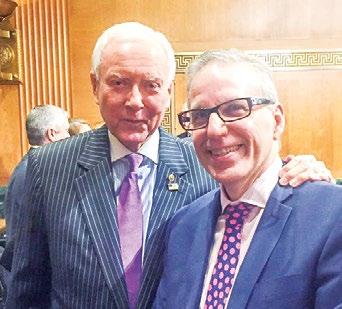


There’s an old saying in Washington that if you’re not at the table, you’re on the menu. The AAN works every day to maintain its seat at that table, so the needs of neurologists and their patients are effectively represented.

AANe-news. Because Your Time Is Valuable.
Sent to your email address the second and fourth Wednesday of each month, AANe-news™ delivers the latest top headlines and resources from the Academy so you can quickly scan and connect directly with the information you need to know. Another members-only solution from your AAN.
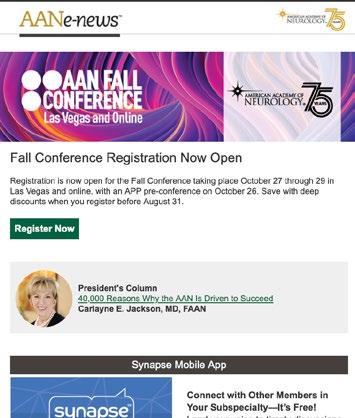
A ANnews • September 2023 19
Lee H. Schwamm, MD, FAAN, right, with Sen. Orrin Hatch (R-UT) after testifying during the CHRONIC Care Act Hearing, 2017.
Marc Raphaelson, MD, (second from left) and staff Luana Ciccarelli, Amanda Becker, and Matt Kerschner met with regulators at the Centers for Medicare & Medicaid Services, 2019.
President Terrence L. Cascino, MD, FAAN; CEO Catherine M. Rydell, CAE; and Ralph L. Sacco, MD, MS, FAHA, FAAN, at White House, 2016.
For Neurology off the Hill, Nina Yakovlevna Riggins, MD, FAAN, left, hosted Rep. Jackie Speier (D-CA) during grand rounds at the University of California–San Francisco, 2019.
















































